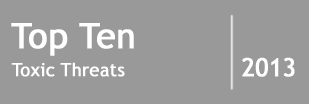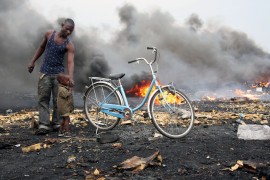Agbogbloshie, Ghana
Pollutant: Lead
Population Affected: 40,000+
Agbogbloshie, in Accra Ghana, is the second largest e-waste processing area in West Africa. E-waste, or electronic waste, is a broad term referring to a range of electronics, including refrigerators, microwaves, and televisions. Because of the heterogeneous composition of these materials, recycling them safely is complex and can require a high level of skill.
Ghana annually imports around 215,000 tons of secondhand consumer electronics from abroad, primarily from Western Europe, and generates another 129,000 tons of e-waste every year.[1] Assuming growth continues in a linear manner, Ghana’s e-waste imports will double by 2020. Approximately half of these imports can be immediately utilized, or reconditioned and sold.[2] The remainder of the material is recycled and valuable parts are salvaged.
A range of recovery activities take place in Agbogbloshie, each presenting unique occupational and ecological risks. The primary activity of concern from a public health perspective is the burning of sheathed cables to recover the copper material inside. Styrofoam packaging is utilized as a fuel to burn the material in open areas. Cables can contain a range of heavy metals, including lead. To some extent, these metals can migrate through particulate in the smoke, while significant amounts are also left behind on area soils.
Agbogbloshie is a vibrant informal settlement with considerable overlap between industrial, commercial, and residential zones. Heavy metals released in the burning process easily migrate into homes, food markets, and other public areas. Samples taken around the perimeter of Agbogbloshie, for instance, found a presence of lead levels as high as 18,125 ppm in soil.[3] The US EPA standard for lead in soil is 400 ppm. Another set of samples taken from five workers on the site found aluminum, copper, iron, and lead levels above ACGIH TLV guidelines. For instance, it was found that one volunteer had aluminum exposure levels of 17 mg/m3 compared with the ACGIH TLV guideline of 1.0 mg/m3.[4]
A conservative estimate of the population at risk might fall in the area of 40,000 people.[5] However, a more in-depth assessment would be required to better capture the risk, which might affect as many as 250,000 people. Since 2008, Blacksmith Institute and partner, Green Advocacy Ghana (GreenAd), have been piloting technologies to aid recyclers in replacing the burning process. Hand wire-stripping tools introduced in 2010 were met with a small-degree of success but burning remained the preferred method. Currently, project partners are working to mechanize the wire-stripping process through the creation of work stations outfitted with a variety of wire-stripping machines. These machines eliminate air pollution and centralize recycling to reduce wide-spread communal exposures. Comprehensive health and occupational safety trainings, implemented since 2008, have built the capacity of workers and community members for reducing the risk of heavy metal exposure.
[1] Feldt, Torsten, Julius N. Fobil, Jurgen Wittsiepe, Michael Wilhelm, Holger Till, Alexander Zoufaly, Gerd Burchard, and Thomas Goen. 2013. High levels of PAH-metabolites in urine of e-waste recycling workers from Agbogbloshie, Ghana. Science of the Total Environment 466-467, 1 (January): 369-376.
[2] Amoyaw-Osei, O.O. Agyekum, J.A. Pwamang, E. Mueller, R. Fasko, M. Schleup. 2011. Ghana e-waste country assessment. SBC E-Waste Africa Project. Available at: http://www.ewasteguide.info/files/Amoyaw-Osei_2011_GreenAd-Empa.pdf#page=1&zoom=110.00000000000001,0,849
[3] Caravanos, Jack, Edith Clark, Richard Fuller, and Calah Lambertson. 2011. Assessing Worker and Environmental Chemical Exposure Risks at an e-Waste Recycling and Disposal Site in Accra, Ghana. Journal of Health and Pollution 1, 1.
[4] Caravanos, Jack, Edith Clark, Richard Fuller, and Calah Lambertson. 2011. Assessing Worker and Environmental Chemical Exposure Risks at an e-Waste Recycling and Disposal Site in Accra, Ghana. Journal of Health and Pollution 1, 1.
[5] PeaceFM Online: Time up for Sodom and Gomorrah; September 4, 2009. Available at: http://news.peacefmonline.com/news/200909/25988.php




